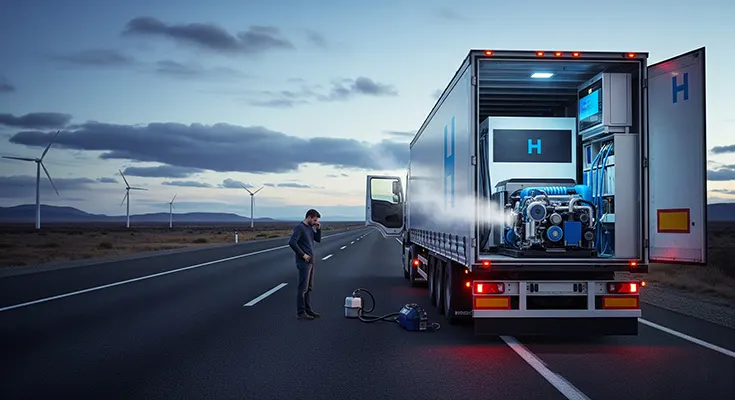As the world races to decarbonize the transportation sector, hydrogen fuel cells have emerged as a promising alternative for heavy-duty commercial vehicles. For long-haul trucks, buses, and other fleet vehicles, hydrogen offers the potential for long range and quick refueling times, addressing two of the primary limitations of battery-electric vehicles (BEVs). However, despite this potential, the widespread adoption of hydrogen-powered commercial transport faces a formidable set of challenges that must be overcome before it can truly compete with diesel and electric rivals.
The “Chicken or Egg” Dilemma of Infrastructure
Perhaps the most significant and immediate challenge is the glaring lack of hydrogen refueling infrastructure. Unlike the rapidly expanding network of electric charging stations, hydrogen stations are few and far between, often concentrated in specific regions like California or parts of Germany. This creates a classic “chicken or egg” dilemma: fleets are hesitant to invest in hydrogen vehicles without a reliable refueling network, while companies are reluctant to build that network without a guaranteed demand from a substantial fleet.
Furthermore, building a hydrogen refueling station is a complex and expensive undertaking, requiring significant capital investment. The infrastructure needed for heavy-duty vehicles, which require high-pressure fueling and large-volume storage, is even more complex and costly than for passenger cars. For hydrogen to be a viable option, a dense network of stations must be built along key freight corridors and in major logistics hubs, a massive undertaking that will require close collaboration between governments, energy companies, and transportation providers.
The High Cost of the Hydrogen Ecosystem
The total cost of ownership (TCO) for hydrogen-powered commercial vehicles remains a major barrier. This is a multi-faceted problem, encompassing both the cost of the vehicle itself and the cost of the fuel.
- Vehicle Purchase Price: Fuel cell electric vehicles (FCEVs) are currently significantly more expensive to produce than their battery-electric or diesel counterparts. This is due to the high cost of components like the fuel cell stack, hydrogen storage tanks, and the limited economies of scale in their manufacturing. While prices are expected to fall as production ramps up, this initial cost premium makes a strong business case difficult for fleet operators.
- Fueling Costs: The cost of hydrogen fuel is a major factor, and it varies wildly depending on how the hydrogen is produced. Currently, most hydrogen is produced from natural gas, a process known as “grey hydrogen” that still generates carbon emissions. The truly clean “green hydrogen,” produced via electrolysis using renewable energy, is currently far more expensive. This means that a fleet’s desire to be “green” may come with a substantial increase in operational costs. While it is expected that the price of green hydrogen will decrease with the scale-up of production and a decline in renewable energy costs, this is not a guaranteed reality yet.
A Complex Production and Distribution Network
Hydrogen’s clean use at the tailpipe belies a complex and often carbon-intensive production process. For hydrogen to be a truly zero-emission solution, it must be produced using renewable energy sources. This requires a vast build-out of electrolysis plants and a robust electrical grid to power them.
Beyond production, the challenges of storing and distributing hydrogen are significant. Hydrogen gas is less energy-dense than diesel fuel and requires high-pressure tanks, which can be heavy and take up valuable space on a truck. The transportation of hydrogen from production sites to refueling stations also adds to the cost and complexity of the supply chain, a challenge that is largely absent from BEVs that draw their energy directly from the grid.
The Competition from Battery-Electric Vehicles
Finally, hydrogen commercial vehicles face stiff competition from increasingly capable BEV trucks and vans. For short- to medium-haul routes, urban deliveries, and return-to-base operations, BEVs are already a viable and often more economical solution. The total cost of ownership for BEV commercial fleets is rapidly declining as battery prices fall and charging infrastructure becomes more widespread. While battery weight and charging times remain a challenge for long-haul trucking, advancements in battery technology and the development of high-speed charging corridors are steadily eroding hydrogen’s traditional advantages.
In conclusion, hydrogen-powered commercial transport holds immense promise, particularly for heavy-duty applications that require long ranges and quick turnaround times. However, the path to widespread adoption is fraught with significant challenges related to infrastructure, cost, and the complexity of the entire hydrogen ecosystem. For hydrogen to realize its potential, a concerted effort is needed to build a robust refueling network, bring down the cost of production and vehicles, and create a strong, clean supply chain that can truly power a new era of sustainable logistics.













